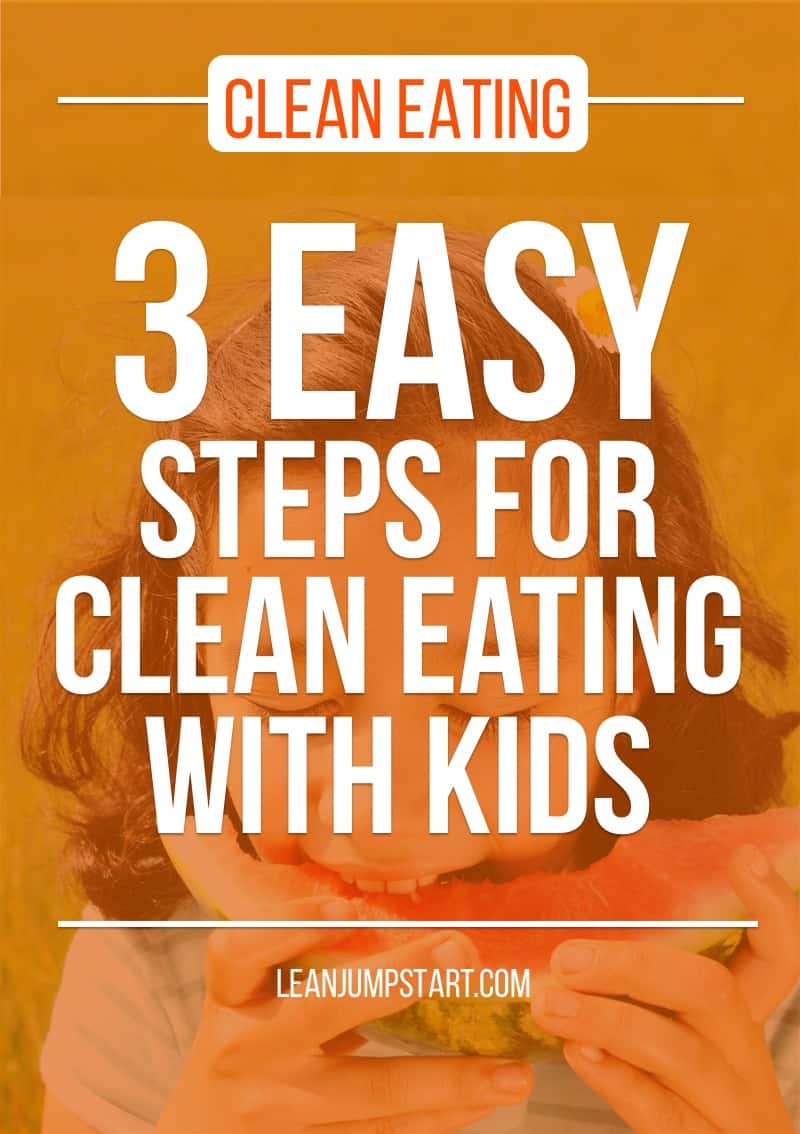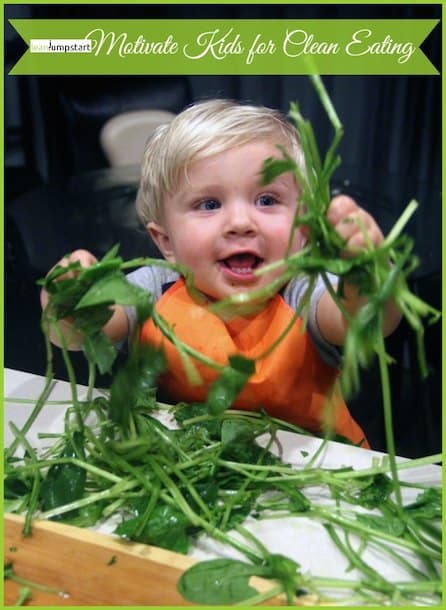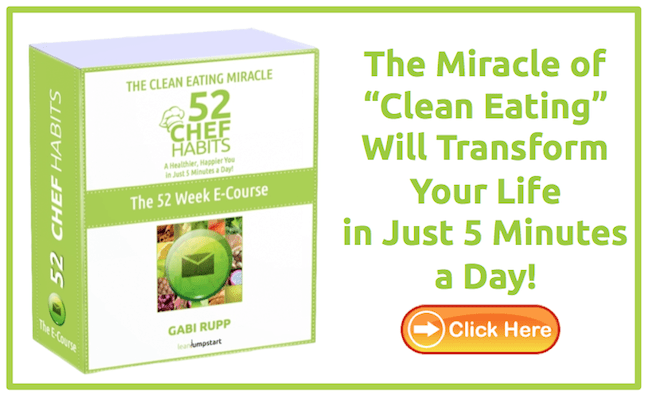In this week’s clean eating for kids challenge, I will show you some easy ways to motivate your children for healthy food choices. All you have to do is try some of the strategies and stick to those that work best for your children.
Daily barriers in nutrition education
Fast food restaurants, kiosks, gas stations, and also the microwave at home in combination with the freezer allow your children to consume food outside of regular meal times – detached from the family.
Apparently, more important events distract our youngsters from eating. This trend starts as early as kindergarten. Kids eat on the go and don’t want to interrupt their playtime. Eating and drinking is then a minor matter; it is viewed in such situations as part of the fun. If children need to prepare meals, it becomes a strain and takes away from their fun.
Knowledge about the preparation of meals has been lost in many families. If parents can’t cook, then it is almost impossible for children to learn this important life skill.
Children learn from role models
Simple bans and rigid guidelines, which is how they were practiced in the past, didn’t have much success. Reasonable arguments like “that makes you fat“ or “this is unhealthy“ don’t change the habits of your kids.
In fact, this can even promote eating disorders. Children live in the “here and now” and can hardly imagine what the future will bring. Modern child psychologists and nutrition experts advocate motivating children with fun instead of advice on “clean” or “healthy” eating.
The beginning and cornerstone of healthy habits for children is made by eating and drinking in the family. The behaviors of parents play a crucial role.
Lead with example
As kids imitate the habits of grown-ups, they usually prefer the same food as people around them. Attitudes and values are copied too.
If you, for example, express that you don’t like fish, then it is unlikely that your children will develop a preference for fish. In later years, friends, kindergarten, school – but also commercials on TV – will determine your kid’s eating habits. Until the time of school enrollment, kids receive the most essential impressions. All nutrition education after this time is endlessly more difficult.
Did you know that all clean eating changes I’ve presented so far can be applied to kids too?
But children don’t really listen to their minds when eating or drinking. They are influenced by their feelings, and that’s why food has to look as appealing, smell wonderful, feel good, and taste superb. Once eaten, they want to get that happy-all-over feeling. Children taste, smell, and feel much more sensitive than grown-ups.
3 step habit change for kids
An important keystone habit for kids is to eat a sufficient amount of fiber-rich fruits and vegetables per day. You want to make it a habit to include a fruit or vegetable portion with each meal of your children: in the morning, for lunch, for dinner, and in between.
Step 1: Use each of your kids’ meals as a trigger.
Step 2: Include a portion of vegetable or high fiber fruits with each meal. (e.g., Fruits in the muesli, lunch sandwiches with vegetables, dinner with a salad, and snacks with fruits or veggies too.)
Kids are eating even more with their eyes than grown-ups. Over 90 % of their perception is made through their visual senses. Real food that looks fun and great stimulates the appetite even more.
As children love finger foods, cut fruits and vegetables into small pieces or use a cookie cutter to cut out funny animals or other cute forms.
Warm colors like red, orange and yellow are great seducers: tomatoes, radishes, bell peppers, and corn are therefore well received. Pure “green,” however, is sometimes regarded as “too healthy” and might be refused – serve it preferably with other colors in a mix. (e.g., Green salad with some slices of red bell peppers.)
Step 3: After sticking to this habit for a week, invest in a kid-friendly lunch box that assists you in packing healthy and hassle-free lunches! (e.g., the Yumbox Leakproof Bento Lunch Box with different departments.)
As kids don’t want chaos on their plates, such a lunch box is an optimal solution. Kids love different components – but separated from each other – and that’s exactly what you can do with this lunch box.
8 top tips for children
- Develop regular mealtimes – week #28: Eating is part of our social lives. Try to develop a regular schedule. Three main meals with two breaks, one in the morning one in the afternoon, are perfect. Watching TV or playing while eating should be avoided (challenge week #6). If your kid isn’t hungry at mealtime, they should still sit with you at the table and get the option of tasting some healthy food. Kids need fun with their meals, and regular family meals where they can talk, laugh, listen, and savor are fun and support strong family relationships. A lovely set table and a harmonic atmosphere play an important role too.
- Make the eating experience an adventure: Children are usually very conservative with their eating. They likely always prefer their same favorites, like French fries, pasta, or pizza. To get more variation into their meals, try to offer different consistencies and taste directions. Raw fruits and vegetables crack when chewing, mashed potatoes feel soft in the mouth. Sour tastes different than salty, sweet, or bitter. For younger kids, it can be a great idea to make a quiz out of their meals: How does the dish smell or taste? How does it feel in your mouth or in your hands? What are the ingredients it contains? The more often you confront your child with certain foods, the easier they will develop a preference for it.
- Involve them in meal planning and cooking: Children, even during their younger years, can take responsibility for their nutrition. This considerably promotes their autonomy. Include your children actively in your meal planning. Let them decide between two or three alternatives. If your children learn as much as possible about a food, they develop a special relationship with it. A potato tastes different if they see where it grows and how to cook it (which doesn’t happen when they are served instant mashed potatoes). Cooking and baking together is fun. Allow your kids to assist you with your food preparation and cooking. That way they will value your meals even more.
- No taboos for certain foods: Taboos make unhealthy foods more attractive. If you cook French fries or pizza, combine them with some whole foods. Offer a mixed salad as a starter before the pizza or French fries. Don’t forbid sweets, chocolates, and ice-cream in general; offer processed foods as seldom indulgences or try a switch to dark chocolate. Here again, the 80/20 approach to clean eating comes in handy.
- Don’t force it: Kids have a still functioning hunger-satiety-regulation system that stabilizes their body weight in the long term. It is totally ok if children eat less on certain days. They usually catch up within the following days. They are also born with a dislike for trying new things (Neophobia). Often you have to offer a toddler something up to 16 times before it accepts it.
- Disguise it: If your youngster in spite of all tricks doesn’t eat a certain food, don’t force them to eat it. You could try instead to disguise it with small cheat meals. Hide small bell pepper cubes on a pizza or finely mix chopped zucchini in your vegetable or meat sauce. You could also try to disguise fish in a casserole dish or make tuna patties.
- Replace it: Another strategy is to replace it with another food that your kid loves more. If your child loves tomatoes and sweet potatoes but hates bell peppers and zucchini in spite of several tries, then give them predominantly tomatoes and sweet potatoes. Click through to learn about the top 26 high fiber vegetables.
If your child doesn’t like fish, replace it with protein-rich poultry and try again later. Bear in mind that tastes are not only different but they also change over time. For the necessary omega 3 fatty acids, sprinkle some chia seeds or line seeds over their cereals, salad, or smoothies. Chia and linseeds could be added to almost any meal. - Never use eating as a reward: Don’t use food as punishment or reward. Kids should mind their natural hunger and satiation feeling and should never be forced to clean their plates as this could encourage emotional eating and food issues in later years.
The more you implement these healthy tips for kids presented in this article, the faster long-winded discussions about food will decrease in the long term.
Now it’s your turn!
Do you already practice clean eating for kids? If yes, that’s great! How do you motivate your children to take up healthier eating habits? I look forward to your best tips and thoughts in the comment section below.




